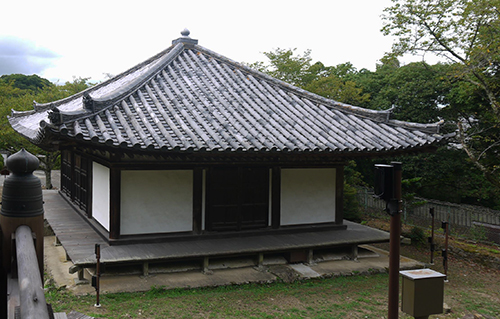


天正13年(1585年)紀伊は寺社勢力や惣国一揆といった、
天下人を頂点とする中央集権に真っ向から対立する勢力の蟠踞する地だった。
根来・雑賀の鉄砲による軍事的脅威もさることながら、
一揆や寺社の体現する思想支配そのものがあらたな天下人への脅威だった。
その意味で信長の伊勢・伊賀攻めと並んで戦国争覇を勝ち抜いた軍事政権の
最終的な武装民衆「根絶やし」の軍事作戦と言えるのでしょう。
先日亡くなった白土三平さんの「忍者武芸帳・影丸伝」が描いた
日本戦国期にさまざまに展開していた地域権力の多様性が否定され
近世的武家専制政権が最終的に勝利した記念碑的な争乱だった。
「われは遠くより来て、遠くまで行くのだ」
中学高校と少年期のわたしはこうした白土三平の描いたアナーキーな
中世民衆の抵抗運動の視点に立ちたい願望をずっと抱いていた(笑)。
結局日本の歴史は武家専制政権を樹立させたけれど、可能性としては
各地域毎の支配構造が多彩な「多様性」に満ちているという
そういった権力形態の共和国というのも確かにあり得たのだと思う。
加賀一向一揆、わたしの縁のある兵庫県・英賀御堂宗教勢力支配をも内包した
分権的日本のありようというのも見てみたかった気もする。
たぶん中央政治体制としては破綻したままの室町政権が存続した国家。
内実は各地域で武家専制もあり紀州や加賀のように
宗教権力による分散支配もあるという共和国国家体制でしょうか。
こうした宗教勢力支配の根源は地域守護権力からの「不入権」だったのでしょう。
寺社勢力支配地域では守護の支配権力が及ぶことがなかった。
守護支配にとっての罪人であっても寺社勢力地域では自由が保障されていたし、
寺領というカタチで巨大な経済力(根来寺で72万石といわれる)を基礎に
寺社領内は経済的自由都市として発展を遂げていた。
室町時代末期最盛期には坊舎450を数え一大宗教都市を形成し
寺領72万石・1万余の根来衆とよばれる僧兵軍団を擁していた。
いい、悪いではなくこういう多様な権力による国家社会というのもあり得た。
信長、秀吉という専制体制を飛ばして多様性のまま継続するニッポン。
もしそうであったら、わたしたち日本人のDNAはまた違ったものになったかも知れない。
とにかくもこの根来寺は秀吉の中央政権による根絶やし攻撃を受けて
大量の鉄砲戦力も大津波に洗われるように無力化されてしまった。
天下をこぞっての大軍勢にとっては鉄砲部隊による先鋒部隊の戦力消耗などは
意に介さずに津波のように押し寄せて根来衆を包囲殲滅したのでしょう。
根来寺はほぼすべての建築群が兵火で灰燼に帰しこの大師堂と大塔だけが残った。
大塔には銃弾痕が生々しく残っているけれど、この大師堂にはないといわれる。
たぶん最後の抵抗を大塔に立て籠もって展開しそして宗派の象徴建築を
灰燼に帰すにしのびなく無念の思いを抱きながら武装放棄し皆殺しされた。
写真の大師堂建築は根来寺草創期以来の残存建築と思われる。
根来寺創設者の覚鑁ではなく真言の遠祖・空海を建築名に残しているのには
初源の根来寺の姿を想起させる気がします。
内部の写真では空海の「弘法大師」号が飾られている。
また、建築としては根来寺建築の基本パターンとして亀腹の基壇・基礎と
それを保護するかのような手すりもない濡れ縁張り出しが特徴的。
建立1391年南北朝時代当時の寺院建築の日本的マザーだったのでしょう。
English version⬇
[“Daishido” Kishu Negoroji Temple, where Hideyoshi Negoro attack soldiers also prolong their lives]
In the 13th year of the Tensho era (1585), Kii was called the power of temples and shrines and the rebellion of Sokoku.
It was a place where the forces that were in direct opposition to the centralization with the world’s people at the top were snarling.
In addition to the military threat of the guns of Negoro and Saika,
The ideological rule itself that embodies Ikki and temples and shrines was a threat to new heavenly people.
In that sense, the military government that won the war-torn country battle alongside Nobunaga’s attack on Ise and Iga
It can be said that it is the final military operation of the armed people “eradication”.
Drawn by Sanpei Shirato’s “Ninja Martial Arts Book, Kagemaruden” who died the other day
The diversity of regional powers that had been developed during the Warring States period of Japan was denied.
It was a monumental struggle that the modern samurai tyranny finally won.
“We come from far away and go far away.”
In junior high school and high school and as a boy, I was anarchy drawn by Sanpei Shirato.
I have always had a desire to stand in the perspective of the resistance movement of the medieval people (laughs).
In the end, Japanese history established a samurai tyranny, but it is possible.
It is said that the control structure of each region is full of various “diversity”
I think that such a form of power could certainly have been possible.
Kaga Ikko-ikki also included the rule of religious powers in Hyogo prefecture and Eigamido, which I have a connection with.
I also wanted to see what decentralized Japan might be like.
Perhaps the nation where the Muromachi administration, which remained bankrupt as a central political system, survived.
In fact, there is a samurai tyranny in each area, like Kishu and Kaga.
Is it a republican national system that there is also decentralized rule by religious power?
Perhaps the root of such religious rule was “non-entry” from the local guardian power.
In the area controlled by temples and shrines, the power of guardianship did not reach.
Even if it was a sinner for guardian rule, freedom was guaranteed in the area of temples and shrines.
Based on the huge economic power of the temple territory (it is said to be 720,000 stones at Negoroji)
The territory of temples and shrines was developing as an economically free city.
At the height of the end of the Muromachi period, 450 shrines were counted to form a major religious city.
It had a temple territory of 720,000 stones and more than 10,000 Negoro-shu, a monk soldier corps.
It was possible that there was a national society with such diverse powers, not good or bad.
Japan skips the tyranny of Nobunaga and Hideyoshi and continues to be diverse.
If so, our Japanese DNA may have been different.
Anyway, this Negoroji Temple was attacked by Hideyoshi’s central government to eradicate it.
A large amount of gun force has also been incapacitated so that it can be washed away by the tsunami.
For a large army all over the world, the exhaustion of the force of the vanguard unit by the gun unit is
It would have siege and annihilate the Negoro-shu by rushing like a tsunami without any intention.
In Negoroji, almost all the buildings were returned to ash by fire, and only this daishido and the great tower remained.
Ammunition holes remain vividly in the tower, but it is said that this Daishido does not.
Perhaps the last stand was erected in the tower and unfolded, and the symbolic architecture of the sect
He abandoned his armed forces and was killed, with a feeling of regret, even though he was abandoned in the ashes.
The Daishido architecture in the photo seems to be the remaining architecture since the early days of Negoroji Temple (around 1140).
The reason why Kukai, the ancestor of the mantra, is left in the architectural name instead of the Kakuban of the founder of Negoroji Temple
I feel that it reminds me of the appearance of Negoro-ji Temple, the first source.
In the photo inside, Kukai’s “Kobo Daishi” issue is displayed.
In addition, as for architecture, the basic pattern of Negoro-ji architecture is the foundation and foundation of the turtle belly.
It features a wet edge overhang without a handrail as if to protect it.
It must have been the Japanese mother of temple architecture in 1140.
Posted on 11月 24th, 2021 by 三木 奎吾
Filed under: 住宅マーケティング, 日本社会・文化研究, 歴史探訪







コメントを投稿
「※誹謗中傷や、悪意のある書き込み、営利目的などのコメントを防ぐために、投稿された全てのコメントは一時的に保留されますのでご了承ください。」
You must be logged in to post a comment.